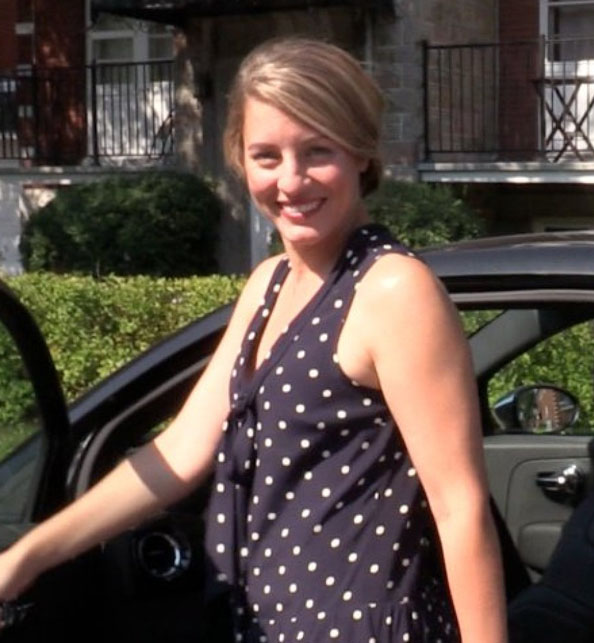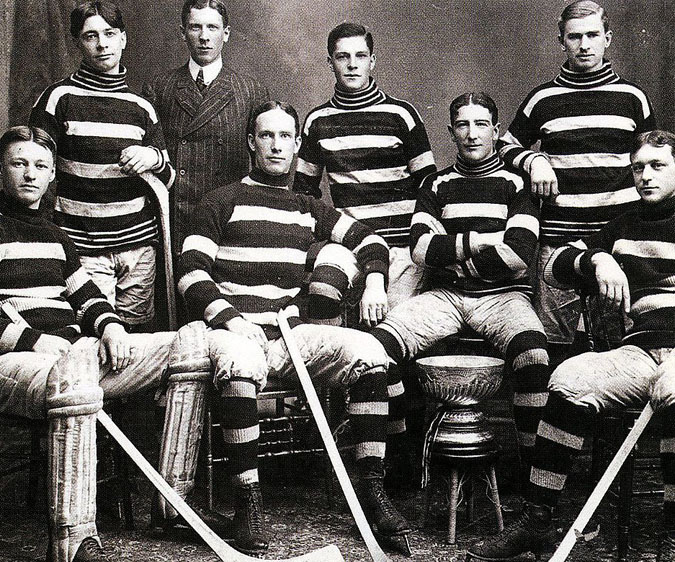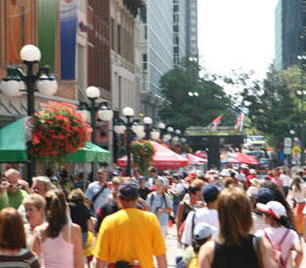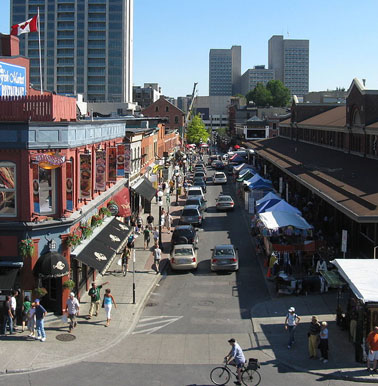Is Ottawa still “the last lumber village before the North Pole”.. and what should be done about it for 2017?
Jan 18th, 2016 | By Citizen X | Category: In Brief
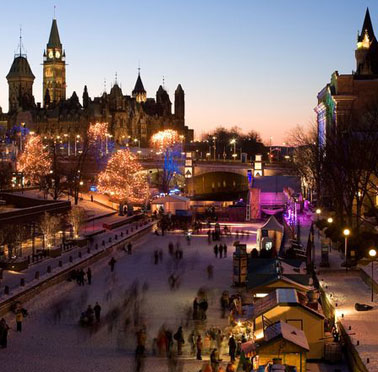
Ice skaters on the world’s longest skating rink–the frozen Rideau Canal, a 19th century waterway that runs through downtown Ottawa today.
The text for this Monday morning is Tim Harper’s piece in the Toronto Star, Friday, January 15, 2016 : “Why is our nation’s capital so drab? … On the eve of our 150th anniversary, it’s time to pierce Ottawa’s torpor and begin to showcase our capital.”
Mr. Harper’s piece is in turn a response to Andrew Cohen’s Tuesday, January 12, 2016 article in the Ottawa Citizen : “Ottawa is the worst capital city in the G7.” And, as a longstanding fan of Andrew Cohen’s, I confess that I have consulted his arguments too.
Both Mr. (T) Harper and Mr. Cohen have more first-hand experience with Ottawa than I have. I first visited the place in my mid teens, at a church young peoples’ convention. (My life may have been a better one if I’d continued my religious affiliations of those early days … but it is too late for that now … )
My first visit took place sometime around 1960, when it certainly seemed that Ottawa was a stodgy small city in need of various repairs, at the very least. I have visited and/or stayed in Canada’s capital region and/or its environs more than a few times since then — including over several decades in which I had assorted family ties to the place.
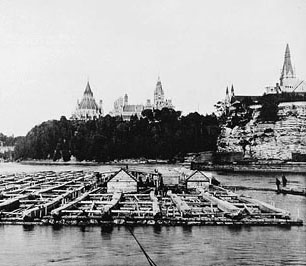
A timber raft on the Ottawa River near Parliament Hill, 1899 (photo by William James Topley, courtesy Library and Archives Canada/PA-144140).
I’d say there was some improvement (in some respects at any rate) during the regime of Pierre Elliott Trudeau. But that was long ago now. And whatever else, anyone who thinks of Stephen Harper’s Ottawa as any kind of fun city probably ought to be institutionalized. (Even with his rock band and the down-to-earth Laureen Teskey Harper’s prairie hospitality.)
So I can only agree with both Andrew Cohen and Tim Harper. In fact, to me Ottawa today essentially remains what the ancient Sage of the Grange in Toronto, Goldwin Smith, called it during the early years of the present confederation : “the last lumber village before the North Pole.” As my favourite old left-wing professor from the late 1960s would say, the only serious policy question is What Is To Be Done?
1. Time for ‘Haussmannization’ of Ottawa
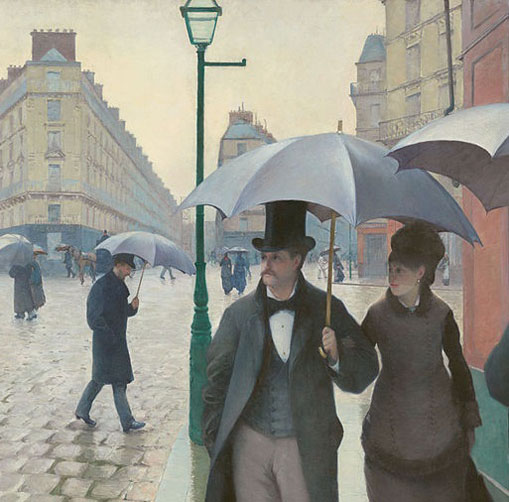
Rainy day in Baron Haussmann’s only recently modernized Paris, as seen by painter Gustave Caillebotte, 1877 – a decade after Canadian confederation.
As it happens, I believe I have an answer to hand, gleaned from a used book I purchased at an excellent bookstore in Jerry Brown’s beautiful renovated (but still struggling) downtown Oakland, California, last spring.
The book is called Paris Babylon : The Story of the Paris Commune. It is written by Rupert Christiansen — the “English writer, journalist and critic, grandson of Arthur Christiansen (editor of the Daily Express) and son of Kay and Michael Christiansen (editor of the Sunday and Daily Mirror).” And it was first published in the middle of the 1990s.
Rupert Christiansen is actually rather critical of the handiwork of the French public servant, Georges-Eugene Haussmann, who “modernized” Paris during the “Second Empire” regime of Napoleon III, from 1852 to 1870.
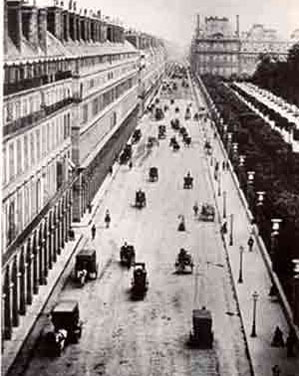
“The Rue de Rivoli … in 1855 … the first boulevard built by Haussmann … served as the model for … others.”
Yet as Richard Bernstein explained in an otherwise enthusiastic 1995 review of Christiansen’s book in the New York Times : “‘Haussmannization’ … it would seem … did work. Who, knowing Paris today, argues against it seriously?”
And now, with only half my tongue in cheek (for those who may still be wondering), I think I know just what Canada’s capital city almost exactly needs during the new “Sunny Ways” Canadian regime of Trudeau II, from late 2015 to who knows just when.
It’s the appointment of some bold and brave public administrator or civil engineer or architect or urban planner, to more or less completely redesign and renovate the downtown core and related environs of Ottawa in the second (and no doubt third) decades of the 21st century, much as Baron Haussmann did in Paris during the third quarter of the 19th century.
Forget the sophomoric Sparks Street Mall of 1967 and all that. What Ottawa needs now is some at last serious ‘Haussmannization’ of its own.
Note eg the Honourable Melanie Joly, MP for Ahuntsic-Cartierville, Minister of Canadian Heritage in Prime Minister Justin Trudeau’s first cabinet. Could she herself even be the Baron Haussmann Ottawa needs so desperately today? Or as Andrew Cohen has noted, it at least needs some kind of big structural renovation that will “do for our city what the Guggenheim Museum did for Bilbao, Spain.” (And btw I have recently been in Bilbao, Spain, and taken photographs of the Guggenheim Museum there — designed by the architect Frank Gehry from Los Angeles, who spent the first 18 years of his life in Toronto!)
As Tim Harper has explained, whatever else “there is hope. Much is invested in the Ottawa Centre MP and environment minister Catherine McKenna and Heritage Minister Melanie Joly.”
The Hon. Melanie Joly in particular, I think myself, probably already knows some suitable 21st century variation on Baron Haussmann (or knows someone else who knows such a person), burning to take on the challenge of finally civilizing the last Canadian lumber village before the North Pole — now that the last spring log drive down the Ottawa River was replaced by trucks on highways as long ago as 1990.
2. But where will the money come from ????
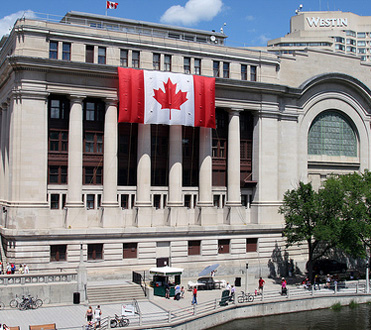
Old Ottawa downtown train station. Subsequently used as conference centre. Slated as temporary quarters for controversial Senate of Canada, during renovations to its quarters in 2018.
Of course, and especially in our present apparently somewhat problematic economic circumstances at the unsettling start of 2016, it is all too easy to dismiss any plea for serious ‘Haussmannization’, modernization, or even just a Guggenheim Museum-type project in the Ottawa Census Metropolitan Area (CMA) with the plaintive cry of “Who will pay for it?”
Here I have (I think) two answers — short run and long run (granted that, as John Maynard Keynes, the brilliant English economist who married a Russian ballerina, liked to remind us, “in the long run we’ll all be dead.”)
In the long run I think our attitude in these matters just ought to be “if you build it they will come.” Any successful as well as much-needed modernization of the Ottawa cityscape today will require some degree of public promotion. And we the taxpaying people should not be shy or ungenerous about providing the required funds. If Napoleon III could afford to modernize Paris in the 19th century, Trudeau II can afford to do the same for Ottawa in the 21st century. You have to spend money to make money, etc, etc, etc …
I have a somewhat different short run view here. But to explain it properly I must first say a few words about what Canadian thing it is that will be having its 150th anniversary on July 1, 2017.
3. What’s really important about 2017 anyway?
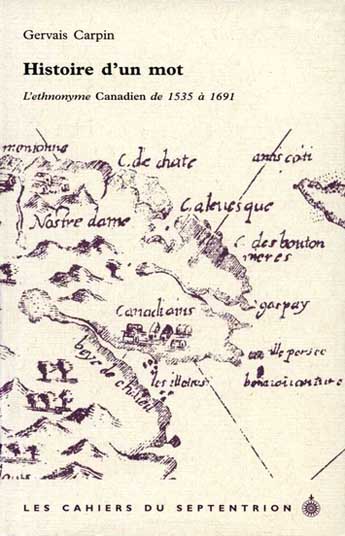 It is commonly said by far too many individuals who should know better, in my view at any rate, that this coming January 1, 2017 will mark the “150th birthday of Canada.”
It is commonly said by far too many individuals who should know better, in my view at any rate, that this coming January 1, 2017 will mark the “150th birthday of Canada.”
This is simply wrong. To start with,” Canada” is an aboriginal or indigenous or native North American word whose origins go much further back than 150 short years ago. So … who knows just when the word itself was “born”?
Second, even if we restrict ourselves to the chunk of geography and so forth that began its modern history as “Canada,” we are talking about a birth in at least the 17th and arguably even the 16th century.
As Wikipedia reports : “From 1535 to the 1690s, the French word Canadien had referred to the First Nations the French had encountered in the St. Lawrence River valley at Stadacona and Hochelaga. At the end of the 17th century, Canadien became an ethnonym distinguishing the inhabitants of Canada from those of France.” (And this is based on a 1995 scholarly publication by Gervais Carpin, Histoire d’un mot : L’ethnonyme Canadien de 1535-1691.)
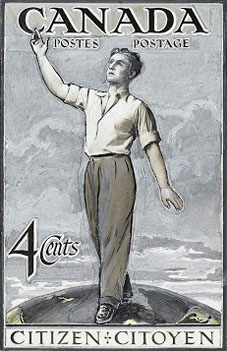
“Canadian citizenship, as a status separate from British nationality, was created by the Canadian Citizenship Act, 1946, which came into effect on 1 January 1947. Canada Post Office issued a stamp to commemorate Canadian citizenship on July 1, 1947, the 80th anniversary of Confederation.”
Finally, if what we mean by Canada is the homeland of the independent Canadian people today, the place is, strictly speaking, younger than quite a few of us still alive today. It begins with the first Canadian Citizenship Act of 1947, which created the present-day status of a Canadian citizen. Before that, reaching back to 1763, residents of Canada remained colonial British subjects. (And as an added twist here, there is George VI’s Letters Patent of 1947, which transferred his powers as British monarch of Canada to the Canadian Governor General!)
So … just what is it about Canada as we know it today that formally, or legally and constitutionally, began on July 1, 1867?
The point is nicely captured in the English lyrics to the immortal (if also rather sophomoric) song “CA-NA-DA” – “written by Bobby Gimby in 1967 … and … commissioned by the Centennial Commission (a special Federal Government agency).” As in the chorus : “North south east west / There’ll be happy times, / Church Bells will ring, ring, ring / It’s the hundredth anniversary of / Confederation / Ev’rybody sing together!”
In the same spirit 2017 will mark the 150th anniversary of the 1867 Canadian confederation, which formally established at least the beginnings of the political and institutional framework The Canadian Federalist Experiment more or less still has today. In 1867 this political and institutional framework was merely the first self-governing dominion of the British empire. Its international status has evolved subsequently, and Canada in this sense today is an independent member state of the United Nations. Yet it is a characteristic part of Canada’s unique history that it is not really possible to assign an exact date to the point at which Canada became an altogether independent country. (And there are some, myself included, who would say that, even now, the task will not be altogether complete, until we formally divest ourselves of the still lingering official symbolism of our colonial ties with the British monarchy across the seas.)
4. Commissioning a 30-Year Plan for Capital City Renovation, 2017—2047
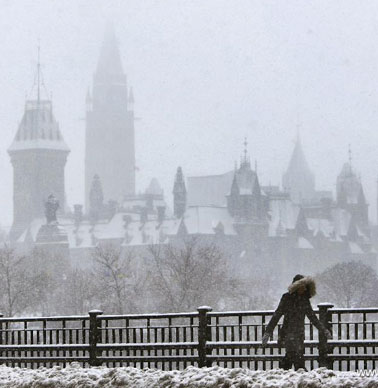
Parliament Hill in the snow, January 13, 2012. Haussmannization must of course take account of this seasonal wonder too!
The upshot of this account of the significance of 1867 is that the 150th anniversary of the present Canadian confederation in 2017 is necessarily something less than the most important thing in Canada’s living history today.
Who knows, that is to say, exactly when Canada as a modern country was actually (or still will be) “born”? Â July 1 each year is not anything’s “birthday.” It is just, as Bobby Gimby explained in 1967, the “anniversary” of “CON-FED-ER-A-TION – Ev-‘ry-bod-y-sing-to-ge-ther.”
And for such an occasion it is just not necessary to spend a great deal of money on a present.
In this spirit, in any case, in the short term what I’d finally propose as the answer to What Is To Be Done about the current abysmal and defiantly uninspiring cityscape of Canada’s capital region in the early 21st century is just the quite inexpensive development of a set of plans for the extensive ‘Haussmannization’ of Ottawa, over the next three decades, say, ending with the centennial of the first Canadian Citizenship Act in 2047.
The plans would be commissioned by some felicitous combination of Ottawa Centre MP and environment minister Catherine McKenna and Heritage Minister Melanie Joly within the next few months. And they would have a due date of July 1, 2017!
It might be nice if some small beginning could be made on the plans in time for, say, the end of 2017 in December – some initial imaginative renovation of the ByWard Market / Marche By, eg. But what real chance of any of this is there, of course? At the same time, if we the Canadian people today are really serious about a more serious and interesting future for Canada and the confederation of 1867 in the 21st century, who can doubt that something like this ought to happen, as Tim Harper and Andrew Cohen have recently and so compellingly made clear!
